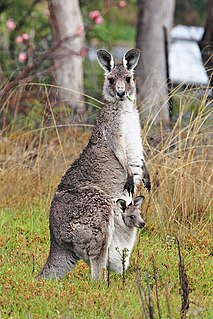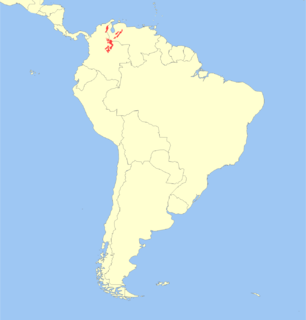
Chipmunks are small, striped rodents of the family Sciuridae. Chipmunks are found in North America, with the exception of the Siberian chipmunk which is found primarily in Asia.

Mammals are vertebrate animals constituting the class Mammalia, and characterized by the presence of mammary glands which in females produce milk for feeding (nursing) their young, a neocortex, fur or hair, and three middle ear bones. These characteristics distinguish them from reptiles and birds, from which they diverged in the late Triassic, 201–227 million years ago. There are around 5,450 species of mammals. The largest orders are the rodents, bats and Soricomorpha. The next three are the Primates, the Cetartiodactyla, and the Carnivora.

Marsupials are any members of the mammalian infraclass Marsupialia. All extant marsupials are endemic to Australasia and the Americas. A distinctive characteristic common to these species is that most of the young are carried in a pouch. Well-known marsupials include kangaroos, wallabies, koalas, possums, opossums, wombats, and Tasmanian devils. Some lesser-known marsupials are the dunnarts, potoroos and cuscuses. Marsupials represent the clade originating from the last common ancestor of extant metatherians. Like other mammals in the Metatheria, they give birth to relatively undeveloped young that often reside in a pouch located on their mothers’ abdomen for a certain amount of time. Close to 70% of the 334 extant species occur on the Australian continent. The remaining 100 are found in the Americas — primarily in South America, but thirteen in Central America, and one in North America, north of Mexico.

The striped polecat - also called the African polecat, zoril, zorille, zorilla, Cape polecat, and African skunk - is a member of the family Mustelidae that resembles a skunk. The name "zorilla" comes from the word "zorro", which in Spanish means "fox". It lives predominantly in dry and arid climates, such as the savannahs and open country of Central, Southern, and sub-Saharan Africa, excluding the Congo basin and the more coastal areas of West Africa.

Zatheria is a group (sublegion) of mammals that includes the common ancestor of Arguimuridae, Vincelestidae, Peramuridae and Tribosphenida.

The Eurasian pygmy shrew, often known simply as the pygmy shrew, is a widespread shrew of northern Eurasia. It is the only shrew native to Ireland.

The Ussuri white-toothed shrew is a species of musk shrew found on the mainland Northeast Asia. It is common and widespread, and is one of the largest shrews found in the region, with adult weight of 14-25 grams. It should not be confused with the related Ussuri shrew.

The long-clawed shrew is a species of shrew. An adult long-clawed shrew has a weight of less than 20 g and a body length of 54–97 mm, with a tail of 40–53 mm. It is distributed through the uplands of northeastern Asia, including northeastern North Korea.

The Siberian large-toothed shrew is a species of shrew. An adult Siberian large-toothed shrew has a weight of 4.6-6.0 grams and a body length of 5.5-6.4 centimeters, with a tail of 2.4-3.75 centimeters. This species is found across Northeast Asia, from Mongolia through northeastern China to the Russian Far East and the Paektusan region of North Korea.
Mammal Species of the World: A Taxonomic and Geographic Reference is a standard reference work in mammalogy giving descriptions and bibliographic data for the known species of mammals. It is now in its third edition, published in late 2005, which was edited by Don E. Wilson and DeeAnn M. Reeder.
The wildlife of Uganda is composed of its flora and fauna. Uganda has 364 species of mammals and 1062 species of birds.
The Wildlife of Nigeria is composed of its flora and fauna. Nigeria has about 290 species of mammals and 940 species of birds.

Baird's shrew is a species of mammal in the family Soricidae. It is endemic to northwest Oregon. Baird's shrew inhabits moist conifer forests. Its fur is darker brown in winter than in summer, when it is brownish-chestnut or olive brown, with paler sides and belly. Males and females are about the same size, which is common among shrews in general. Also like other shrew species, Baird's shrew feeds on insects, worms, snails, and spiders. It shares the forests of its range with six other species of shrew, such as the Pacific shrew. Body length ranges from 100 to 143 mm, with an average weight of 7.6 g, but ranging anywhere from 5.5 to 11.2 g.

The Mérida brocket, also known as the Meroia brocket or rufous brocket, is a small species of deer. It is found in forest and páramo at altitudes of 1,000–3,500 metres (3,300–11,500 ft) in the Andes of northern Colombia and western Venezuela. It was once treated as a subspecies of the similar Little Red Brocket, but has been considered a distinct species since 1987, though as recent as 1999 some maintained it as a subspecies.

The Indochinese short-tailed shrew is a species of mammal of the family Soricidae found in China and Vietnam.

Cladotheria is a group (legion) of mammals that includes the ancestor of Dryolestoidea, Peramuridae and Zatheria.
The Bangweulu tsessebe is a subspecies of antelope found in northeastern Zambia. The tsessebes in northeastern Zambia in the southern Bangweulu Flats are classified by Naturalist F. Cotterill as a new species based on differences in pelage and cranial morphology.
The Brooke's duiker is a species of antelope. It is distributed throughout Liberia, Sierra Leone and Côte d'Ivoire. It was elevated to species status.















